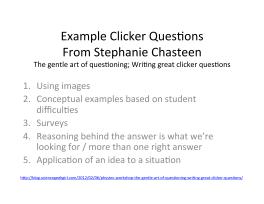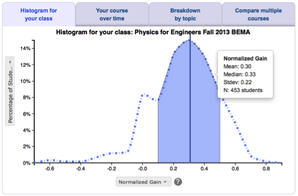








middle schoolhigh schoolintro collegeinter-mediateupper levelgrad school other

calc based

alg based

conceptual









Overview
What? Small group discussion of conceptual questions interspersed with lectures, increasing engagement and providing formative feedback on student thinking. Students first answer questions individually with classroom response system, then discuss with their neighbors and answer again.
Why? Peer Instruction is an easy way to add interactivity to a traditional lecture course without making drastic changes. It can get your students engaged and talking, and help you learn and respond to what your students are thinking, both of which can lead to improved student learning.
Why not? Peer Instruction is a band-aid on a traditional lecture course structure, which is not ideal for student learning. If you have the opportunity to make a more drastic change to your course structure, or to engage students in working on longer and more meaningful problems, consider doing so.
Classroom video
More about what it looks like…Activity outline
| Presentation of a topic in Peer Instruction | ~15 min |
| Mini-lecture | 7-10 min |
| Question posed | 1 min |
| Students think quietly on their own | 1-2 min |
| Students record/report initial answers | <1 min |
| Students discuss their answers in small groups | 2-4 min |
| Students record/report initial answers | <1 min |
| Feedback to teacher: tally of answers | <1 min |
| Explanation/discussion of correct answer | 2+ min |
Student skills developed
- Conceptual understanding
- Problem-solving skills
- Making real-world connections
- Using multiple representations
- Metacognition
Instructor effort required
- Low
Resources
Peer Instruction Implementation Guide
Everything you need to know about implementing Peer Instruction in your class.
Book: E. Mazur, Peer Instruction: A User's Manual (Prentice Hall, Upper Saddle River, 1997). Mazur's book contains an introduction to the method, an overview of the research behind it, directions for implementation, and a CD with a library of ConcepTests.
Blog: Turn to Your Neighbor is the official Peer Instruction blog, with many suggestions from the developers about how to implement Peer Instruction effectively.
Online Clicker Resource: The University of Colorado Science Education Initiative has developed an online guide to using clickers in STEM classrooms, including suggestions for effective implementation, videos, a podcast, and links to other resources.
Video: Eric Mazur discusses his experience creating Peer Instruction:
Teaching Materials
See our Expert Recommendation on finding good questions to use with clickers or Peer Instruction for an extensive list of databases of Peer Instruction questions, as well as suggestions for writing your own questions. Many instructors use the collection of Peer Instruction questions on the CD that comes with the Peer Instruction Book:
E. Mazur, Peer Instruction: A User's Manual (Prentice Hall, Upper Saddle River, 1997), pp. 253.
Research
This is the second highest level of research validation, corresponding to:
- at least 1 of the "based on" categories
- at least 2 of the "demonstrated to improve" categories
- at least 4 of the "studied using" categories
Research Validation Summary
Based on Research Into:
- theories of how students learn
- student ideas about specific topics
Demonstrated to Improve:
- conceptual understanding
- problem-solving skills
- lab skills
- beliefs and attitudes
- attendance
- retention of students
- success of underrepresented groups
- performance in subsequent classes
Studied using:
- cycle of research and redevelopment
- student interviews
- classroom observations
- analysis of written work
- research at multiple institutions
- research by multiple groups
- peer-reviewed publication
References
- E. Corpuz and R. Rosalez, The Use of a Web-Based Classroom Interaction System in Introductory Physics Classes, presented at the Physics Education Research Conference 2010, Portland, Oregon, 2010.
- C. Crouch, A. Fagen, J. Callan, and E. Mazur, Classroom demonstrations: Learning tools or entertainment?, Am. J. Phys. 72 (6), 835 (2004).
- C. Crouch and E. Mazur, Peer instruction: Ten years of experience and results, Am. J. Phys. 69 (9), 970 (2001).
- C. Crouch, J. Watkins, A. Fagen, and E. Mazur, Peer Instruction: Engaging Students One-on-One, All at Once, in Research-Based Reform of University Physics, edited by E. Redish and P. Cooney, (American Association of Physics Teachers, College Park, 2007), Vol. 1.
- K. Cummings and S. Roberts, A Study of Peer Instruction Methods with High School Physics Students, presented at the Physics Education Research Conference 2008, Edmonton, Canada, 2008.
- M. Dancy, C. Turpen, and C. Henderson, Why Do Faculty Try Research Based Instructional Strategies?, presented at the Physics Education Research Conference 2010, Portland, Oregon, 2010.
- D. Demaree and S. Li, Promoting productive communities of practice: An instructor’s perspective, presented at the Physics Education Research Conference 2009, Ann Arbor, Michigan, 2009.
- A. Fagen, C. Crouch, and E. Mazur, Peer instruction: Results from a range of classrooms, Phys. Teach. 40 (4), 206 (2002).
- M. James, The effect of grading incentive on student discourse in Peer Instruction, Am. J. Phys. 74 (8), 689 (2006).
- M. James, F. Barbieri, and P. Garcia, What Are They Talking About? Lessons Learned from a Study of Peer Instruction, Astron. Educ. Rev. 7 (1), 37 (2008).
- L. Jones, A. Miller, and J. Watts, Conceptual teaching and quantitative problem solving: friends or foes?, J. Cooperat. Collab. Coll. Teach. 10 (3), 109 (2001).
- V. Kuo, P. Kohl, and L. Carr, Socratic Dialogs and Clicker use in an Upper-Division Mechanics Course, presented at the Physics Education Research Conference 2011, Omaha, Nebraska, 2011.
- N. Lasry, Clickers or Flashcards: Is There Really a Difference?, Am. J. Phys. 46 (4), 242 (2008).
- N. Lasry, E. Charles, C. Whittaker, and M. Lautman, When Talking Is Better Than Staying Quiet, presented at the Physics Education Research Conference 2009, Ann Arbor, Michigan, 2009.
- N. Lasry, E. Mazur, and J. Watkins, Peer Instruction: From Harvard to the two-year college , Am. J. Phys. 76 (11), 1066 (2008).
- J. Lenaerts, W. Wieme, and E. Van Zee, Peer instruction: A case study for an introductory magnetism course, Eur. J. Phys. 24 (1), 7 (2003).
- S. Li and D. Demaree, Promoting and Studying Deep-Level Discourse During Large-Lecture Introductory Physics, presented at the Physics Education Research Conference 2010, Portland, Oregon, 2010.
- M. Lorenzo, C. Crouch, and E. Mazur, Reducing the gender gap in the physics classroom, Am. J. Phys. 74 (2), 118 (2006).
- E. Mazur, Peer Instruction: A User's Manual (Prentice Hall, Upper Saddle River, 1997).
- S. McKagan, K. Perkins, and C. Wieman, Reforming a large lecture modern physics course for engineering majors using a PER-based design, presented at the Physics Education Research Conference 2006, Syracuse, New York, 2006.
- D. Meltzer and K. Manivannan, Transforming the lecture-hall environment: The fully interactive physics lecture, Am. J. Phys. 70 (6), 639 (2002).
- H. Nitta, Mathematical theory of peer-instruction dynamics, Phys. Rev. ST Phys. Educ. Res. 6 (2), 020105 (2010).
- K. Perez, E. Strauss, N. Downey, A. Galbraith, R. Jeanne, and S. Cooper, Does Displaying the Class Results Affect Student Discussion during Peer Instruction?, CBE Life. Sci. Educ. 9 (2), 133 (2010).
- K. Perkins and C. Turpen, Student Perspectives on Using Clickers in Upper-division Physics Courses, presented at the Physics Education Research Conference 2009, Ann Arbor, Michigan, 2009.
- S. Pollock, No Single Cause: Learning Gains, Student Attitudes, and the Impacts of Multiple Effective Reforms, presented at the Physics Education Research Conference 2004, Sacramento, California, 2004.
- S. Pollock, Transferring Transformations: Learning Gains, Student Attitudes, and the Impacts of Multiple Instructors in Large Lecture Courses, presented at the Physics Education Research Conference 2005, Salt Lake City, Utah, 2005.
- S. Pollock, S. Chasteen, M. Dubson, and K. Perkins, The use of concept tests and peer instruction in upper-division physics, presented at the Physics Education Research Conference 2010, Portland, Oregon, 2010.
- S. Pollock and N. Finkelstein, Sustaining educational reforms in introductory physics, Phys. Rev. ST Phys. Educ. Res. 4 (1), 010110 (2008).
- E. Price, C. De Leone, and N. Lasry, Comparing Educational Tools Using Activity Theory: Clickers and Flashcards, presented at the Physics Education Research Conference 2010, Portland, Oregon, 2010.
- C. Singh and G. Zhu, Improving students' understanding of quantum mechanics by using peer instruction tools, presented at the Physics Education Research Conference 2011, Omaha, Nebraska, 2011.
- M. Smith, W. Wood, W. Adams, C. Wieman, J. Knight, N. Guild, and T. Su, Why Peer Discussion Improves Student Performance on In-Class Concept Questions, Science 323 (5910), 122 (2009).
- C. Turpen, M. Dancy, and C. Henderson, Faculty Perspectives On Using Peer Instruction: A National Study, presented at the Physics Education Research Conference 2010, Portland, Oregon, 2010.
- C. Turpen and N. Finkelstein, Understanding How Physics Faculty Use Peer Instruction, presented at the Physics Education Research Conference 2007, Greensboro, NC, 2007.
- C. Turpen and N. Finkelstein, Not all interactive engagement is the same: Variations in physics professors’ implementation of Peer Instruction, Phys. Rev. ST Phys. Educ. Res. 5 (2), 020101 (2009).
- C. Turpen and N. Finkelstein, The construction of different classroom norms during Peer Instruction: Students perceive differences, Phys. Rev. ST Phys. Educ. Res. 6 (2), 020123 (2010).
- E. Watkins and M. Sabella, Examining the Effectiveness of Clickers on Promoting Learning by Tracking the Evolution of Student Responses, presented at the Physics Education Research Conference 2008, Edmonton, Canada, 2008.
- J. Watkins and E. Mazur, Just-in-Time Teaching and Peer Instruction, in Just in Time Teaching: Across the Disciplines, Across the Academy (2009), p. 39.
- G. Zhu and C. Singh, Improving students’ understanding of quantum measurement. II. Development of research-based learning tools, Phys. Rev. ST Phys. Educ. Res. 8 (1), 010118 (2012).









